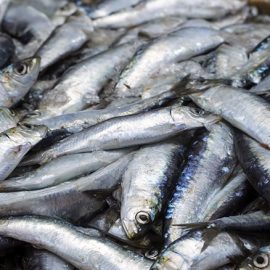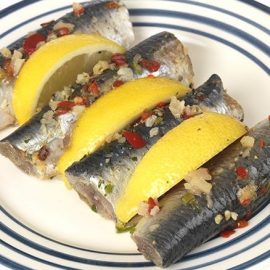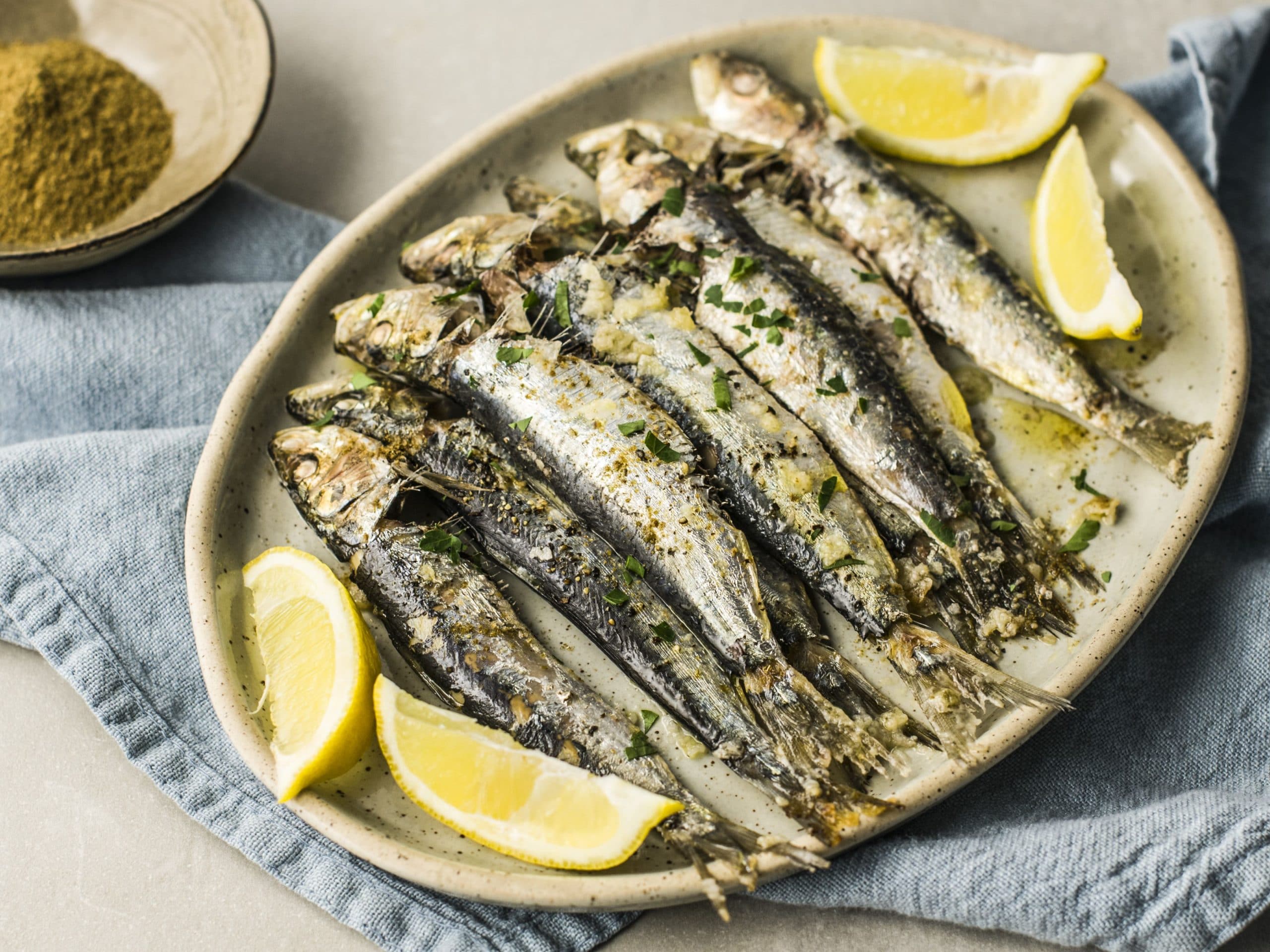
Introduction
Sardines, also commonly known as pilchards, are small, silvery, edible fish of the family Clupeidae. They are found in oceans across the globe and are a significant source of nutrition for many people.
Not only are sardines an excellent source of essential omega-3 fatty acids, vitamins, minerals, protein, calcium, iron, and phosphorus, but they are also used to make various dishes.
In the Mediterranean, fresh sardines are mostly grilled and served with vegetables and sauces. In the United States, they are canned for convenience and often used in sandwiches, pasta, and gratin dishes.
They are also popular in Asia, with sardine fish widely used as soup, curry, and snack ingredients. Common spices that give sardines a distinct flavour include garlic, ginger, shallots, lemon juice, turmeric, and black pepper.
There are numerous species of sardines which provide essential sustenance for humans and other creatures in their respective marine ecosystems. As such, careful management and conservation of these species are required to ensure their populations stay healthy and plentiful.
Description
Sardine is a generic term for many species of small, oily and heavily salted fish belonging to the Clupeidae family. Since the 15th century, the term “sardine” has been used to describe fish species from the Sardinian region of Europe and the Gulf of Lion.
The genus name of sardines is Sardina, derived from the Latin sar-dinus, meaning ‘of Sardinia’. Other variants of the same fresh fish species include pilchards and herrings. At the same time, alternative etymologies propose the word could be a composite of the Latin sarus, meaning “amber-coloured”, and the Greek chini, meaning “small fish,” or an apparent contraction of the Greek sardina or sarda, meaning “viper”.
Types of Sardines
The family contains many species of sardines, such as the European sardine (Sardina pilchardus), the Japanese sardine (Sardinops melanostictus), the Pacific sardine (Sardinops sagax), the Mediterranean sardine (Sardina pilchardus), the South American pilchard (Sardina galaxias), the Atlantic herring (Clupea harengus), the Australian herring (Arripis truttse), and the Pacific herring (Clupea pallasii). European and Japanese sardines are the most popular types.
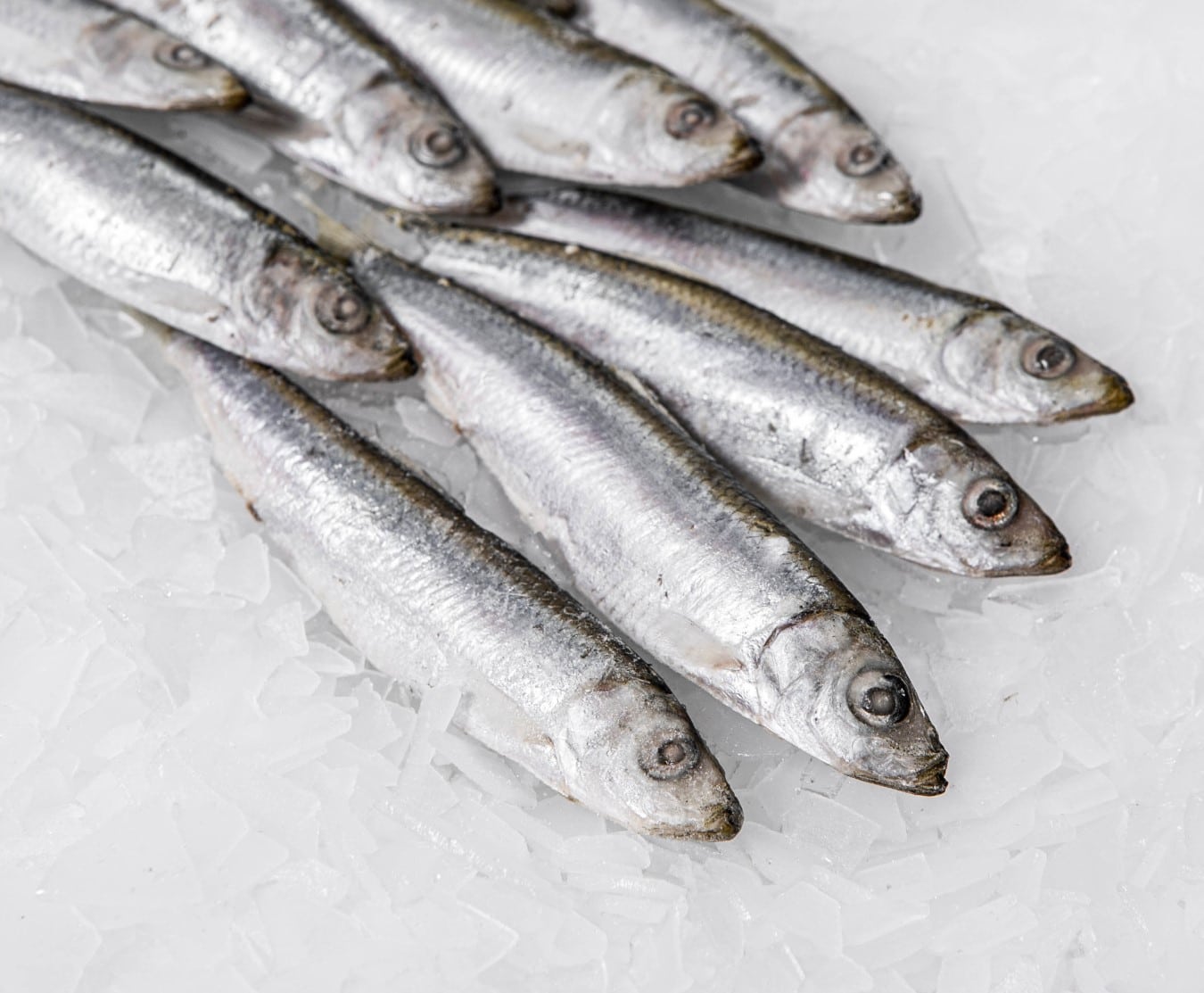
Physical Characteristics
Sardines typically measure between 2-5 inches (5-13 cm) in length and weigh 0.7-4.25 ounces (20-130 grams). They have a long, cylindrical body with a single dorsal fin located in the middle of the back. Interestingly, the silver or grey colouration of their scales, fins and tails, with a darker backside, acts as camouflage to help them blend in with the surrounding ocean.
Habitat
Sardines inhabit shallow, temperate and subtropical marine waters with depths ranging from 10 to 200 meters and have been known to inhabit brackish and estuarine waters occasionally. They generally prefer nutrient-rich waters with rounded productivity and cooler temperatures; thermospheres are often found in their natural habitat, where the temperature decreases with depth.
Distribution of Stocks
Sardines are widely distributed across the world’s oceans and seas, with the greatest concentration usually found in the temperate waters of the Mediterranean Sea. Most species are found in the northern and eastern Atlantic oceans, the Mediterranean Sea, and the western and central Pacific Oceans. Some can also be found off the coasts of Africa, Australia, and most of the Indian Ocean.
Sardines Fisheries
Sardine fisheries are an essential food source and economic stability for countless communities worldwide. They provide crucial jobs and generate substantial economic opportunities, which is why the sustainability of sardine fisheries must be considered.
Population and Conservation
Some species of sardines have been classed as near-threatened or vulnerable due to overfishing and habitat decline. Whenever selecting sardines to eat, it is vital to check that the source is sustainably and ethically sourced.
Sardines are a vital fishery resource and essential to many coastal ecosystems. Due to their far-reaching implications, their numbers significantly impact the health and stability of their habitats. Therefore, people and marine biologists are working to ensure that sardine populations are monitored and managed responsibly.
Sustainable Fishing Practices
It is important to note that harvesting for sardines is regulated to ensure the sustainability of the species and its habitat. International regulations oversee the sustainable harvesting of sardines and the implementation of fishing quotas to preserve their populations.
Fisheries management and monitoring are also in place to ensure fishing activities are conducted within sustainable limits and abide by the applicable laws and regulations.
The Marine Stewardship Council (MSC) has adopted management strategies to protect sardine populations, while international conservation organisations have also set regulations and standards for the fishing industry. Additional measures to promote sustainability include creating marine protected areas (MPAs), promoting aquaculture, and exercising selective fishing practices.
Selective fishing techniques are essential for reducing the impact of fishing on sardine populations, avoiding catching non-targeted species, and releasing immature sardines into the environment when possible is a critical factor in the success of these fisheries.
Sardine’s Diet
Sardines are filter feeders and primarily eat plankton. They are often found in large schools, moving in unison with one another. Additionally, sardines are popular bait sources for larger predator fish and are sometimes used as fishing lures.
Life Cycle of Sardines
The life cycle of sardines typically lasts from 1-3 years. Spawning typically begins in mid-summer, with peak spawning times varying among species. Spawning grounds differ between species but are usually found in cooler near-shore waters.
Larvae will feed on zooplankton before transitioning to an adult diet of small fish, crustaceans and other marine creatures. Their growth rate is species-dependent, with some reaching adulthood within a year while others take up to three to do so. The longevity of adults can range from 1-3 years before they reach senescence and die.
Schooling Behaviour
Sardines exhibit a schooling behaviour similar to other fish species, which has evolved to improve their competitiveness, including predator avoidance, mate selection, and successful mating. The sardines have become a critical food source for many marine species, such as cetaceans, seabirds, and other fish.
Sardines have several positive effects on the environment. Their presence helps to maintain the food chain in areas where they are abundant, providing an essential resource for other species. By increasing the availability of food resources, they can also provide shelter and food to numerous fish species that prefer these areas to feed.
Sardines are harvested commercially by many fisheries worldwide, generating significant economic and social contributions to local communities. Their popularity as a food product and the high oil content of the fish means they are a valuable source of nutrition, providing essential fatty acids, protein, minerals and vitamins.

Popularity and Availability
The popularity of canned sardines has increased in recent decades as more people discover their health benefits, convenience and affordability. Canned sardines contain essential fatty acids and are commonly packaged in oil, water, tomato sauce or other sauces. They can be used in many dishes such as salads, pasta, sandwiches, dips and more, and in various commercial products such as pet foods, sauces, soups and spreads.
Nutritional Values
Sardines are an excellent source of heart-healthy fatty acids, particularly rich in Omega-3s, making them an ideal unique source of protein. Additionally, they are rich in essential vitamins such as Vitamin B12 and beneficial minerals such as calcium and zinc. Sardines contain high levels of vitamins A, D, and B12 and selenium.
Sardines are rich in healthy omega-3 fatty acids. A 3.75-ounce serving of sardines contains 1,116 mg of omega-3 fatty acids, which is about four times more than other fatty fish.
Health Benefits
Sardines are especially renowned for their health benefits and nutritional value. They are an excellent source of vitamins, minerals, omega-3 fatty acids, and polyunsaturated fats. Their combination of affordability and ease of preparation, and health benefits, make them an attractive and nutritious option for both home cooks and chefs alike.
The majority of calories in sardines come from protein and healthy fat. Studies have suggested that regular intake of sardines may reduce inflammation and increase bone mineral density; this is due to their high omega-3 fatty acid content, which is higher than other oily fish. In addition, sardines are low in mercury and toxins, making them a safe and healthy choice for people of all ages.
Studies have found that eating sardines may help increase bone mineral density and offer other nutritional benefits.
Taste and Texture
The flavour profile of sardines tends to be salty and savoury and goes great with other ingredients like tomato, garlic, onion, lemon, and olives. Though they have a strong flavour, they do not have a strong “fishy” taste. When cooked, sardines flake easily and can be added to various dishes. They also have a unique, delicate flavour with a slightly salty and smoky finish.
Culinary Uses
Sardines are widely consumed all over the world. They are famous for canned food products, salads, and other culinary dishes, providing essential nutrients such as vitamins, minerals and essential fatty acids.
Sardines have been used for a variety of purposes for centuries. Traditionally, they have been utilised as bait fish and for livestock feed. Now, however, their demand for human consumption has grown immensely. Consequently, sardines are a valuable commercial resource, with fisheries producing canned, dried, and salted sardines worldwide.
Preparation
When preparing sardines for cooking, the head and pin bones should be removed, and the fish should be de-headed, de-boned and skinned for easier eating.
Filleting them can be done for added convenience. Seasoning sardines with salt and other spices, such as pepper, garlic, cumin, curry powder, and marinades or sauces, is recommended for added flavour. It can also help to enhance the taste when you add olive oil to the cooking process.
- Grilling – Grilling sardines are a great way to cook them and can bring out their natural flavour. The fish should be placed on metal or wooden skewers to prevent falling through the grates. Taking care not to overcook the sardines is vital when grilling, as they are delicate and can quickly become dry or rubbery. Cook them for approximately 2-5 minutes on each side, depending on their size, then remove them from the heat before they become too dry. Grilling can be done over an open flame, such as a charcoal or gas barbecue.
- Other Cooking Methods – In addition to grilling, sardines can also be fried in a pan with some oil, sautéed briefly, or smoked over an open flame to impart a smoky flavour.
- Smoking is the most common preserving method, and sardines should be smoked at a temperature of 75C (165F) for 8-10 hours. When cooking sardines with steam, they should be cooked for 6-8 minutes until they can easily be flaked with a fork.
Serving
Sardines can be served both hot and cold, depending on personal preference. They can be a delicious and nutritious addition to any meal.
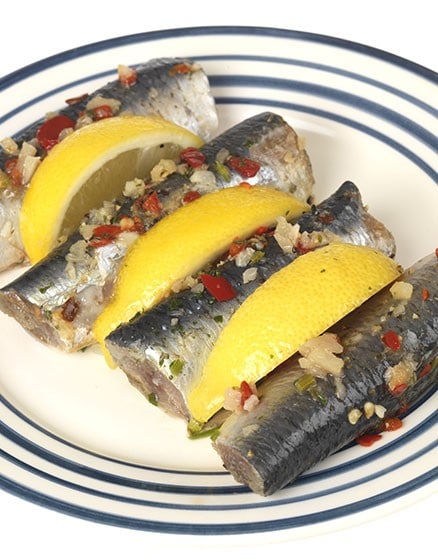
Choosing the Best Side Dishes
Side dishes for sardines often include roasted or grilled vegetables, grains, beans, salads, and potatoes. Popular vegetables that pair nicely with sardines include zucchini, bell peppers, artichoke hearts, onions, mushrooms, eggplants, and tomatoes. Grains such as couscous, quinoa, farro, and millet work well with sardines.
White beans, black beans, pinto beans, and chickpeas can be added for flavour and texture. Salads featuring fresh vegetables such as Roma tomatoes, cucumbers, olives, capers, kale, and arugula complement sardine dishes. Additionally, potatoes are an excellent side dish for sardines and can be boiled, mashed, roasted, or baked.
Enhancing the Flavour With Herbs & Condiments
The unique flavour of sardines can be further enhanced when served with citrus, herbs, garlic, and olive oil. Common herbs and spices complementary to sardines include parsley, basil, oregano, thyme, paprika, rosemary, and garlic. Accompanying sardines with flavourful sauces and condiments such as salsa, hot sauce, tartar sauce, pesto, and aioli can also bring out the flavour of sardines.
Traditional Sardine Dishes
Traditional sardine recipes differ across cultures. They all typically include a combination of common ingredients, including olive oil, garlic, lemon juice, onion, peppers, tomatoes, and herbs such as oregano and parsley.
Popular recipes include sardines marinated in olive oil and herbs, grilled or broiled with vegetables, sardines stuffed with olives and herbs, sardines in tomato sauce, and baked with potatoes.
Other classic recipes include fried sardines with boiled potatoes, sardines in olive oil, and sardines in white wine. Additionally, some traditional recipes use saffron, capers, and olives to enhance the dish’s flavour.
Popular Snacks
In addition to the large variety of traditional recipes, sardines are also a popular snack food. Examples include sardine croquettes and sardine fritters.
For those looking for a more indulgent snack, some recipes call for sardines stuffed with honey, cinnamon, and orange mixture.
Other popular sardine recipes include Sardine Bruschetta, Sardine and Potato Sformato, Pickled Sardines, Sardine Toast, Sardine Rillettes, Canned Sardine Salads, and Char Grilled Sardines.
Conclusion
Sardines have been a staple food for many cultures for centuries. Not only are they affordable and versatile, but they are also jam-packed with nutrients and beneficial vitamins. As such, they are the perfect ingredient for both traditional dishes and modern recipes. Whether served fresh, canned, smoked, pickled, salted or incorporated into sauces and oils, there is something for everyone to enjoy with sardines.
